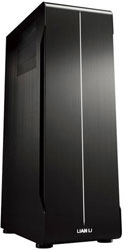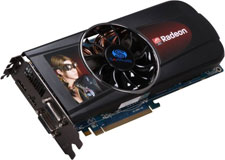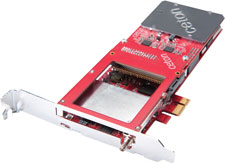Holiday 2010 System Builder's Guide
by AnandTech Staff, edited by Jarred Walton on November 19, 2010 2:00 AM EST- Posted in
- Guides
- Systems
- Holiday 2010
Alan's Ultimate HTPC: Bringing Total Entertainment to the Living Room
Our final build is for those of you who do not like to compromise with your HTPC. Are you tired of hooking up multiple streaming boxes to get all your internet content, NAS for secondary streamers, and another gaming system as well? There are numerous users out there, myself included, that love HTPC as well as gaming. There are many ways to skin the proverbial HTPC cat; this guide is for those of you who want it all in one box on your big screen. There will be sacrifices however, and those come in the size department and in the old pocket book. If you're looking for a small, quiet HTPC that isn't as powerful but doesn't cost an arm and a leg, go look at what Ganesh is pushing.
| Alan's Ultimate HTPC | ||
| Hardware | Component | Price |
| Processor |
Phenom II X6 1090T Black Edition (Thuban 45nm, 3.2GHz, 6x512K L2, 6MB L3, 125W) |
$210 |
| CPU HSF | Noctua NH-D14 | $75 |
| Motherboard | MSI 890FXA-GD70 (AMD 890FX AM3) | $200 |
| Video | Sapphire Radeon HD 5870 1GB (100281-3SR) | $300 |
| GPU HSF | Arctic Cooling Accelero Xtreme | $57 |
| TV Tuner | Ceton InfiniTV4 CableCARD Quad-Tuner | $400 |
| Memory |
G.Skill Ripjaws 2x4GB DDR3-1600 CL9 (F3-12800CL9D-8GBRL) |
$150 |
| OS Drive (SSD) | OCZ Vertex 2 120GB ($20 MIR) | $210 |
| Misc | Icy Dock MB882SP-1S-1B | $20 |
| Hard Drives | 3 x Western Digital Green 2TB (WD20EARS) | $300 |
| Optical Drive | LG UH10LS20 Blu-ray Combo Drive | $85 |
| Case | Lian Li PC-X2000F | $300 |
| Power Supply | Seasonic SS-560KM 560W (80 Plus Gold) ($15 MIR) | $115 |
| Mouse | Razer Mamba | $110 |
| Keyboard | Logitech diNovo Edge | $157 |
| Software | Windows 7 Professional 64-bit (OEM) | $135 |
| Software | Hipporemote Pro | $5 |
| Software | PowerDVD 10 Ultra | $90 |
| Misc | Powermat for iPhone 3GS (PMM-1PB-B2A) | $41 |
| Total System Price | $3015 | |

The first thing to look at for an HTPC is the case, and the most important feature in the case of an HTPC is noise. This is the major problem with multipurpose machines. Gaming cases tend to stay cool but also tend to be noisy and filled with enough LEDs to be mistaken for a flight beacon; after all gamers tend to want to highlight all their high-end hardware. Finding components that will both be cool enough for gaming and quiet enough for a home theater is the key here. A great best of both worlds case is the Lian Li PC-X2000F. At $299 from Newegg as of this writing, the case is pricey, but it currently sports a $200 saving (though that may disappear soon). At that price, I think it is an excellent buy for a home theater/gaming enthusiast.
New to this version is USB 3.0 support and a redesigned case layout. With five 140mm fans, dust filters, and anti vibration solutions, the air-cooling is both highly effective and extremely quiet. Sporting seven HDD bays with the installed back plates for hot-swappable fun, this case has plenty of room for media drives; just make sure your motherboard or RAID card have enough SATA connectors.
Speaking of storage, currently 2TB WD20EARS drives are shipping for $100 and are a great way to expand your media storage capabilities and tend to run on the quiet side of things—no need for a NAS when your HTPC case holds enough traditional HDDs to feed every other device in your home with media! The case is limited to 3.5" drives, but throwing your favorite SSD into an Icy Dock or similar device will allow you to push it right into one of the HDD back plates to get your OS and applications loading at high speed with no noise whatsoever.

For the GPU, I chose AMD because of the bitstreaming support for HD audio codecs. We can argue about performance with the 5870 and 6870, but the 5870 has been around enough that aftermarket cooling solutions are readily available. Add a Noctua cooler to your favorite CPU as well as an Arctic Cooler Accelero on your high-end AMD graphics card for cool and quiet gaming that won't leave you straining to hear during quiet movie scenes. We've also selected a high-efficiency, near-silent 560W power supply from Seasonic to keep everything running; the GPU + CPU combination generally means we need more power than a typical HTPC, but since this is the main feature of the Home Theater/Gaming we went higher end.
At this point, we've taken your NAS or Windows Home Server, HTPC, and gaming PC and combined them into one glorious entertainment system. You'll need help accessing all that media however. Free applications like Boxee and My Movies 3 can help sort local and internet content past what Windows Media Center offers, but pay applications like PowerDVD will integrate well with Media Center and will also play nice with My Movies adding Blu-ray capability into the mix. But there's still more….
The smartphone is one of the best ways I have found to control a Windows-based HTPC. With HippoRemote on your phone and HippoVNC booting on your PC, you can use your smartphone to seamlessly open Windows Media Center, Boxee, Hulu, or myriad other applications. The touchscreen on the phone then transforms into a remote interface designed for the application of your choice. It is a great way to navigate seamlessly between applications that bring you internet or media content without having to browse endless webpages, and there's no need to hack Media Center. The problem is, using your smartphone in this manner depletes the battery at a rapid rate; that's why adding a Powermat on the coffee table will address this problem and charge your smartphone/remote each time you set it down. You'll still want a good wireless mouse as well as a keyboard for gaming. I like the Razer Mamba mouse, while the Logitech Dinovo Mini or Edge are excellent options for the keyboard.

Last but not least, you can add cable TV into your HTPC with a Ceton InfiniTV 4 CableCARD tuner. Although quite expensive and backordered, they bring four simultaneous HD streams into your PC through a single card. Streams can be accessed in other rooms via the Xbox 360, or by adding a network bridge to the tuners (a process still in beta firmware, but it should be available by the time the cards are out of backorder). Or, if you're one of those looking to cut the cable, save $400 and stick with streaming video.
You can see my list of components up top, but play around with what works best for you. I went with an AMD setup to keep the cost slightly lower and chose a single GPU as the system will likely be hooked to an HDTV that will limit the resolution for gaming to 1920x1080. Sadly, the single most expensive item is the CableCARD tuner. But for around $3000, you'll be ripping Blu-rays onto 6TB of storage, controlling your media with your phone, and playing the latest games on your 1080p TV. Enjoy!










112 Comments
View All Comments
raghu1111 - Saturday, November 20, 2010 - link
Sorry for the repost. I thought my earlier comment didn't make it.sjfischr - Saturday, November 20, 2010 - link
I think that it's a fantastic setup. To those commenting on the number of drives, let me tell you...as a Ceton owner myself, it's extremely easy to eat up space. I am already eating about 25% of my 4 TB of space thanks to this wonderful card, and I have owned mine for less than four weeks. 1080p HD takes up a good 5.5GB/hr, so let's be certain that many movies approach 12-15 GB apiece. To be sure, I can record up to 4 NFL games at once, and watch them in fast forward (these of course eat up space like crazy). You will need a huge amount of space over time--6TB will be a fine amount of space for now, but think about the fact that as it progresses, the media library will continue to grow.My only disagreement is on the case. Why get a $300 tower when the Thermaltake DH101 provides arguably one of the best examples in the $250 range? The DH101 is full ATX, is quiet enough for most tastes, has 4-3.5" bays, is tool-less, and has a built-in LCD display/remote. The LCD display recently had a firmware update, making it very easy-to-read, and it extremely customizable. With a supplied IR remote, this enables anyone (not just iPhone/Android folks) to point at the device and find what they want. I combine this with a Logitech diNovo Mini (it's much sleeker), and I agree that this combination of case, remote, and keyboard rate the highest on the Spousal Approval Factor.
just4U - Saturday, November 20, 2010 - link
With options out there for memory that is in the cas 6-7 range I am not quite sure I understand why those of you building the more expensive systems are not considering them..It doesn't make sense. Please explain.
just4U - Saturday, November 20, 2010 - link
A prime example comes from this link (the cas 6 lineup at Newegg)http://www.newegg.com/Product/ProductList.aspx?Sub...
For me it's at the point where I don't care if it it goes higher I want those latancies to come down so ... C9 is great for a budget system but higher end?
JarredWalton - Sunday, November 21, 2010 - link
My personal experience with high-end RAM over the years has been less than ideal. Notice how all the CL6 RAM requires 1.6 to 1.65V, and compatibility with motherboards is less certain. A good mobo should work with it, and it would be faster than CL9 or CL8 memory, but it's not going to be such a huge difference that I'm personally ready to recommend spending $30 more on it. Besides, many of the DDR3 kits can do better timing with a bit of added voltage (just like the CL6 kits). If you want better RAM, by all means go for it, but I'm not promising it will always work.iMav - Sunday, November 21, 2010 - link
Another recommendation for Unicomp. Their keyboards ARE the modern-day Model M's. Not Model M-like, they are honest to goodness Model M keyboards.Definitely check out geekhack.org for more information you'd ever care to know about regarding mechanical keyboards.
jonup - Sunday, November 21, 2010 - link
I can't agree more with Anand's mobo/CPU recommendation. I am personally waiting for Sandy for my next build. Meanwhile, I picked up this yesterday: http://www.newegg.com/Product/ComboDealDetails.asp... . For an extra $4 I got P2X4 940 and a similarly/slightly better spec'ed 785G mobo. I think that the extra core and 6MB of cash are worth the for buck. The trade off is that I am stuck with DDR2 but it is not an issue for me since I have 4GB in the system I am putting it in.All in all, stick with Anand's choice of picking up a cheap CPU/mobo and wait till January/February of next year. I would even extend this recommendation to the choice of SSD. With many new and exciting SSDs coming out soon after the holidays and the lower production costs of the 28nm manufacturing we should expect higher performance/capacity and lower prices once the next generations start popping up. Maybe 60GB for $100-130 or 80-90GB for <$150 would be a smarter investment.
ivaxona - Sunday, November 21, 2010 - link
I've already placed the orders, most of the components arrived.Pjenom II X4 955 - bought second hand
Gigabyte 880GM-UD2H
Corsair xms3 2x2GB 1600MHZ
Seagate 500GB and dvd-rw from my old PC
Antec p180 mini
Seasonic M12II 430W
I will buy a 6850 as soon as i have the money, until then the onboard 4250 has to keep me covered. A Corsair force 60 gb on the long run and better cpu cooler. Maybe i'll wait for a new revision of coolermaster Hyper 212 after the new amd socket arrives :)
GullLars - Sunday, November 21, 2010 - link
I have a couple of points i want to make in critique of this so called "dream PC".First off, while the RevoDrive x2 is a great single part that will not be a bottleneck in any normal system, this is not a normal system, and if you clock the CPUs a bit, it can still be a major bottleneck for bandwidth of incompressible data (like media, compressed or encrypted files).
RAID-5 off ICH10R with 4x 1,5TB HDDs isn't dreamy either (4R5).
Since this is a $8K+ "dream system", i feel it warrants a real hardware RAID controller, like the Areca 1880 with a 4GB stick of RAM. This controller supports 6Gbps SATA/SAS and plays nice with SSDs, and comes with 8-24 ports with good support of expanders, should they be needed. You can also hit 2GB/s bandwidth and >100K random IOPS.
I'd suggest 8R6 Hitachi/Seagate Green 2TB drives + 4-8R0 Crucial C300 from the 12 or 16 port versions. The capacity of the SSDs dedicated by the budget, 8R0 of lower capacity taking priority over 4R0 of higher capacity. OFC with an image of the SSD RAID kept on the HDD RAID, and daily backups of userdata kept on the SSDs.
I'd also list water cooling as an alternative, especially since 2x 580 in SLI would benefit from being watercooled.
eBob - Sunday, November 21, 2010 - link
I was wondering if there are any companies that provide remote control hardware for HTPCs other than Soundgraph/iMon. My current HTPC case has this solution pre-installed and it has been a huge headache. Basically, I am unable to turn power on from the remote after turning power off. If I turn off power at the power supply and turn it back on the remote works, but only once. I am running a Linux OS on this box and apparently Soundgraph is unable or unwilling to support such a setup and their customer support is useless.